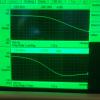Here are some notes on the recent DARM calibration for future reference.
(A) We intentionally do not switch the simulated ETM actuators in the CAL-CS model when we switch to ETMY for low noise in the DARM control.
Even though we switch the actuator from ETMX to ETMY for the LSC DARM control to achieve low noise, the calibration filters for the actuators in CAL-CS remain using the *ETMX simulated actuator path*. Since we adjusted the ETMY ESD digital gain such that the response of ETMX and ETMY ESDs are the same with a precision of 10 % in frequency band from 20 to 60 Hz, the calibrated spectrum after the ETMY transition should be still valid with a precision of 10 %. In other words, we forced the actual ETMY ESD to be identical to that of ETMX so that we don't have to manipulate the filters in CAL-CS. In fact, when we transition from ETMX to ETMY, we do not see visible reduction or increment in the DARM spectrum at low frequencies below 100 Hz, which convinced us that the calibration remained consistent. Then, once we decrease the ETMX ESD bias all the way to zero, we see noise reduction in 20-100 Hz band due to lower ESD noise.
The adjustment of the ETMY ESD digital gain was done on the last Tuesday, Mar-24th (alog 17411). The following is some detail of what I did for the adjustment. First, I measured the transfer function from ETMX_L3_LOCK_L_IN1 to LSC-DARM_IN1 in 20-60 Hz band by swept sine while the interferometer stayed fully locked on DC readout. Then I measured the same transfer function but with the ETMY ESD driven. So the transfer function I took was from ETMY_L3_LOCK_L_IN1 to LSC-DARM_IN1. At this point, I noticed that the ETMY ESD response was weaker than that of ETMX by an overall scale factor of 1.25. Note that both ESDs use the linarization. So I increased the ETMY ESD gain by the same factor in ETMY_L3_LOCK_L_GAIN. So this gain is now 1.25 and this is already coded in the ISC_LOCK guardian. Then in order to check how good the matching is between ETMX and ETMY, I ran another swept sine on ETMY with the new gain. However this still gave me a bit too-weaker ETMY ESD by 10% (I attach the dtt xml file). Since we knew that the overall scaling factor of our calibration is already uncertain by the same level (on the order of 10%, see for example alog 17082), I did not try to get better matching between them. We will revisit the ETMY calibration at some point.
(B) The DARM spectrum below 2 Hz is not trustable.
There are two reasons.
- We have not calibrated the L1 stages yet, the calibration below the cross over frequency (which must be somewhere between 0.5 and 2 Hz) is uncertain.
- We intentionally do not engage two of the simulated suspension digital filters for the L1 stage (i.e. the ones simulating low frequency boosts in ETMX(Y)_L1_LOCK_L, specifically FM1 (zpk([0.3], [0])) and FM2 (zpk([0.1] [0])) ). This makes the calibration inaccurate below 0.3 Hz in such a way that the DARM spectrum becomes too good. Enabling one or both filters tends to accumulate a large DC offset over some time and eventually causes a spill over envelope into the DARM spectrum even if the DC component is subtratced in diaggui.
By how much is the calibration off at low frequencies because we do not include the low-frequency control filters, i.e. Kiwamu's point (B)2? See attached. This is the (driven) transfer function from the DARM_CTRL input of the CAL CS model (actually H1:CAL-CS_DARM_FE_ETMX_L3_ISCINF_L_EXC) to the output of the actuation function chain (actually H1:CAL-CS_DARM_DELTAL_CTRL_WHITEN_IN1). At these low frequencies, the formulation of DELTA L EXTERNAL is entirely dominated by the actuation function times the control signal, A * DARM_CTRL. So, any discrepancies between what we believe is the most accurate reconstruction of A and the real A is by how much that calibration is off. To give a few frequency points in words, at 0.1 [Hz] the discrepancy is roughly an order of magnitude too low, and at 0.02 [Hz] is almost two orders of magnitude off. In other words, any plots of DELTA L EXTERNAL is *under* estimating the displacement by ~10 at 0.1 [Hz] and by 100 at 0.02 [Hz]. This transfer function comparison also reveals (maybe?) what problems that Kiwamu mentions in (B)2. One can see *without* the low frequency compensation, the TFs clean. *With* the low frequency filters engages, the transfer function becomes ratty both at low and high frequencies. Maybe this is a problem with numerical precision in the filter computation?



















